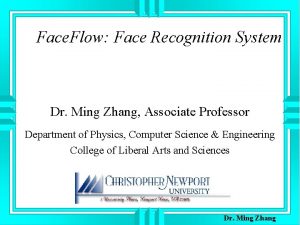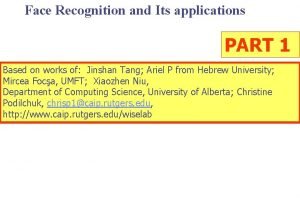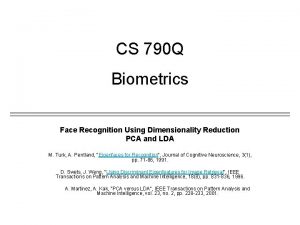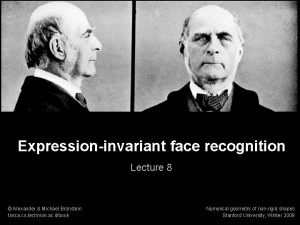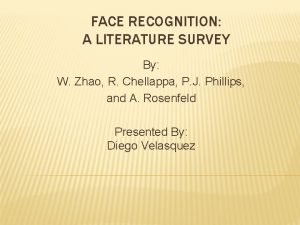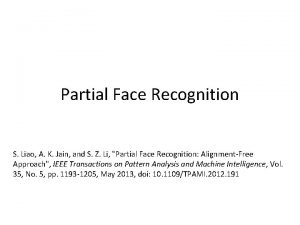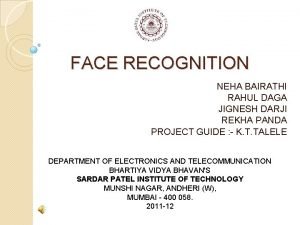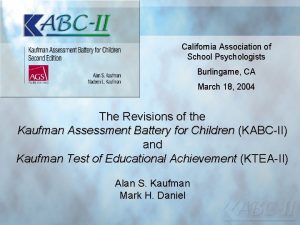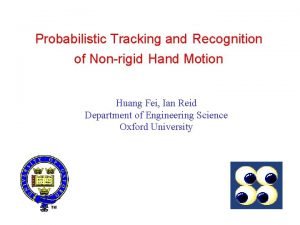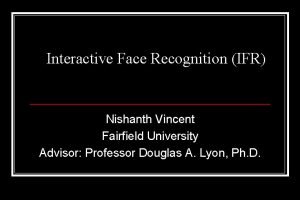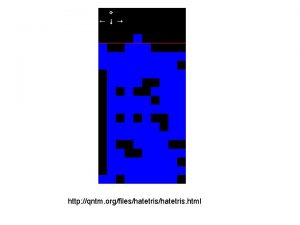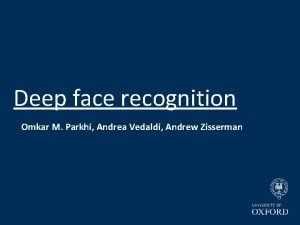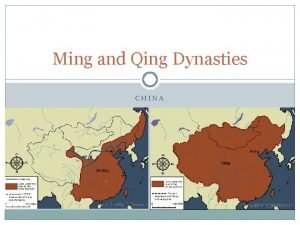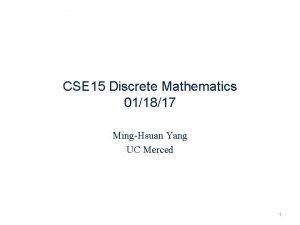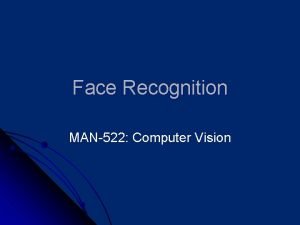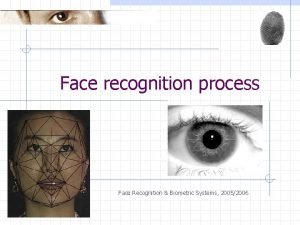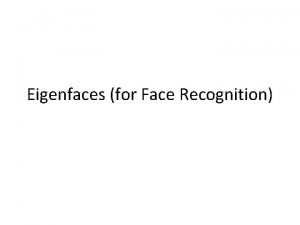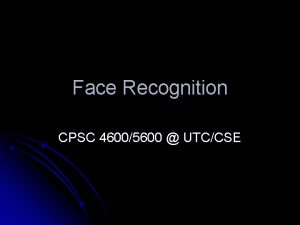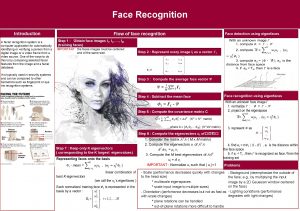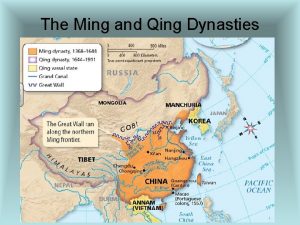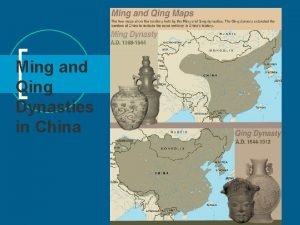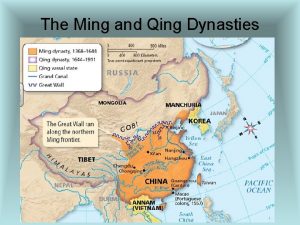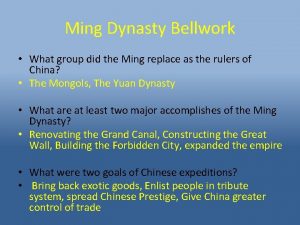Face Flow Face Recognition System Dr Ming Zhang






























- Slides: 30

Face. Flow: Face Recognition System Dr. Ming Zhang, Associate Professor Department of Physics, Computer Science & Engineering College of Liberal Arts and Sciences Dr. Ming Zhang

FACEFLOW (1992 - 2002) A computer vision system for recognition of 3 -dimensional moving faces using GAT model (neural network Group-based Adaptive tolerance Tree) u A$850, 000 supported by SITA (Society Internationale de Telecommunications Aeronautiques) u A$40, 500 supported by Australia Research Council u A$78, 000 supported by Australia Department of Education. u US$160, 000 supported by USA National Research Council.

Why Develop FACEFLOW ? - - To use new generation computer technique, artificial neural network, for developing information systems. No real world face recognition system is running in the world. Big security market - Biometric system - ID card identification system - Car and house security system

What Approved Artificial Neural Network Techniques can : - Can recognition one face in the laboratory using less than 1 second - Currently can recognition about 1000 faces

Next Step • • Rebuild interface for face recognition system Face Detection • Lighting • Background • Make up • • • New neural network models More complicated pattern recognition Build a rear world face recognition System

Microsoft Visual C++. Net Enterprise Version!

Pixel. Smart Image Capture Card Source Codes- Compiled & Linked!

Victor Image Processing Library Running in Visual C++. NET !

Faceflow: Face Model Simulator Test Different Models!

Brain. Maker Neural Network Software the Fastest Training Package!

Explore. Net Neural Network Software The Best Interface Package!

FERET Facial Image Database Standard Face Database!

Edge Detection

Image Processing

Research Lab In Modern Building ! We have a pattern recognition lab in the ARC building We have our own room to do research. Dr. Ming Zhang

Research Topics u Neuron Network Group Models u GAT Tree Model - real time and real world face recognition u Neuron-Adaptive Neural Network Models - best match real world data u Center Of Motion Model - motion center u Second Order Vision Model - motion direction u NAAT Tree Model - a possible more powerful model for face recognition

Dr. Ming Zhang 11/1999 – 07/2000: Senior USA NRC Research Associate NOAA, Funding $70, 000. u 03/1995 – 11/1999: Ph. D. Supervisor University of Western Sydney Funding: A$203, 724 Cash from Fujitsu, ARC, & UWSM u 07/1994 -03/1995: Ph. D. Supervisor and Lecturer Monash University, A$50, 000 Grant from Fujitsu) u 11/1992 -07/1994: Project Manager & P. H. D. Supervisor University of Wollongong, (A$850, 000 from SITA) u 07/1991 -10/1992: USA NRC Postdoctoral Fellow NOAA, Funding: US$100, 000) u 07/1989 -06/1991: Associate Professor and Postdoctoral Fellow The Chinese Academy of the Sciences. Funding: RMB$2, 000 u Dr. Ming Zhang

Hornik, K. (1991) “Whenever the activation function is continuous, bounded and nonconstant, then for an arbitrary compact subset X Rn, standard multilayer feedforward networks can approximate any continuous function on X arbitrarily well with respect to uniform distance, provided that sufficiently many hidden units are available”

Leshno, M. (1993) “A standard multilayer feedforward network with a locally bounded activation function can approximate any continuous function to any degree of accuracy if and only if the network’s activation function is not a polynomial”

Zhang, Ming (1995) “ Consider a neural network piecewise function group, in which each member is a standard multilayer feedforward neural network, and which has locally boundded, piecewise continuous (rather than polynomial) activation function and threshold. Eash such group can approximate any king of piecewise continuous function, and to any degree of accuracy”

Dr. Ming Zhang’ s Publications (Face Recognition) 1 Journal Papers 1) Ming Zhang, Rex Gantenbein, Sung Y. Shin, and Chih-Cheng Hung, The application of artificial neural networks in knowledge-based information systems, International Journal of Computer and Information Science, Vol 2, No. 2, 2001, pp. 49 - 58. 2) Ming Zhang, Jing Chung Zhang, John Fulcher, "Neural network group models for data approximation", International Journal of Neural Systems, Vol. 10, No. 2, April, 2000, pp. 123 -142. 3) Ming Zhang, and John Fulcher, “ Face recognition using artificial neural network groupbased adaptive tolerance (GAT) trees”, IEEE Transactions on Neural Networkis, vol. 7, no. 3, pp. 555 -567, 1996. 2 Patents 1) Ming Zhang, et al, “Translation invariant face recognition using network adaptive tolerance tree”, Australian Patent PM 1828, Oct. 14, 1993. 2) Ming Zhang, Ruli Wang, and Yiming Gong, “Standard nonlinear signal wave generator based on the neural network”, Chinese Patents, No. 90 1 02857. 6, May 17, 1990. Dr. Ming Zhang

Dr. Ming Zhang’ s Publications (Face Recognition) 3 Full Refereed Conference Papers 1) Shuxiang Xu, and Ming Zhang, A Novel Adaptive Activation Function, Accepted by IJCNN’ 2001 (International Joint Conference on Neural Networks’ 2001), Washington DC, USA, July 2001, pp. 2779 – 2782. 2) Ming Zhang, Jing Chung Zhang, John Fulcher, "Neural network group models for data approximation", International Journal of Neural Systems, Vol. 10, No. 2, April, 2000, pp. 123 -142. 3) Ming Zhang, Shuxiang Xu, and Bo Lu, “Neuron-adaptive higher order neural network group models”, in Proceedings of IJCNN’ 99, Washington, D. C. , USA, July 10 -16, 1999. 4) Ming Zhang, Shuxiang Xu, Nigel Bond, and Kate Stevens, “Neuron-adaptive feedforward neural network group models”, in Proceedings of IASTED International Conference on Artificial Intelligence and Soft Computing, Honolulu, Hawaii, USA, August 9 -12, 1999, pp. 281 -284. 5) John Fulcher, Ming Zhang, “Translation-invariant face recognition using the parellel NAT-tree neural network model”, in Proceedings of Parallel Computing. Workshop 1997, Canberra, Australia, 25 -26 September, 1997, pp. P 1 -U-1 – P 1 -U-1 -4. 6) Ming Zhang, John Fulcher, “Face recognition system using NAT tree”, in Proceedings of IASTED International Conference on Artificial Intelligence and Soft Computing, Banff, Canada, July 27 - August 1, 1997, pp. 244 -247. 7) Ming Zhang, and John Fulcher, “Face perspective understanding using artificial neural network groupbased tree”, in Proceedings of International Conference on Image Processing, Lausanne, Switzerland, vol III, September 16 -19, 1996, pp. 475 -478. 8) Ming Zhang, and John Fulcher, “Translation invariant face recognition using a network adaptive tolerance tree”, in Proceedings of World Congress On Neural Networks, San Diego, California, USA, September 15 -18, 1996, pp Dr. Ming Zhang

Dr. Ming Zhang’ s Publications Year 2001 (1) Hui Qi, Ming Zhang, and Roderick Scofield, Rainfall Estimation Using M-PHONN Model, Accepted by IJCNN’ 2001 (International Joint Conference on Neural Networks’ 2001), Washington DC, USA, July 2001, pp. 1620 - 1624. (2) Ming Zhang, and Roderick Scofield, Rainfall Estimation Using A-PHONN Model, Accepted by IJCNN’ 2001 (International Joint Conference on Neural Networks’ 2001), Washington DC, USA, July 2001, pp. 1583 - 1587. (3) Ming Zhang, and BO Lu, Financial Data Simulation Using M-PHONN Model, Accepted by IJCNN’ 2001 (International Joint Conference on Neural Networks’ 2001), Washington DC, USA, July 2001, pp. 1828 - 1832. (4) Ming Zhang, Financial Data Simulation Using A-PHONN Model, Accepted by IJCNN’ 2001 (International Joint Conference on Neural Networks’ 2001), Washington DC, USA, July 2001, pp. 1823 - 1827. (5) Shuxiang Xu, and Ming Zhang, A Novel Adaptive Activation Function, Accepted by IJCNN’ 2001 (International Joint Conference on Neural Networks’ 2001), Washington DC, USA, July 2001, pp. 2779 – 2782 (6) Ming Zhang, Rex Gantenbein, Sung Y. Shin, and Chih-Cheng Hung, The application of artificial neural networks in knowledge-based information systems, International Journal of Computer and Information Science, Vol 2, No. 2, 2001, pp. 49 - 58. (7) Ming Zhang, Shuxiang Xu, and John Fulcher, Neuron-Adaptive Higher Order Neural Network Models for Automated Financial Data Modeling”, Accepted by IEEEE transactions on Neural Networks, July, 2001. Dr. Ming Zhang

Dr. Ming Zhang’ s Academic Service -2002 (1) Member of Technical Committee) for the IASTED (The International Association of Science and Technology for Development) International Conference on Artificial Intelligence and Expert Systems, 2001 - 2004. (2) Paper review for IASTED International Conference on Applied Informatics, 2002 (3) Paper review for IASTED International Conference on Signal Processing, Pattern Recognition, and Applications, 2002 (4) Member of IPC (International Program Committee) for the IASTED (The International Association of Science and Technology for Development) International Conference on Artificial Intelligence and Soft Computing, July 17 -19, 2002, Banff, Canada (5) Member of IPC (International Program Committee) for the IASTED (The International Association of Science and Technology for Development) International Conference on Artificial and Computational Intelligence, September 25 – 27, 2002, Tokyo, Japan. (6) Member of program committee for ISCA International Conference on Computers and Their Applications, April 4 – 6, 2002, San Francisco, California, US Dr. Ming Zhang

Dr. Ming Zhang’ s Academic Service -2003 (1) Member of IPC (International Program Committee) for the IASTED (The International Association of Science and Technology for Development) International Conference on Computer Science and Technology, May 19 -21, 2003, Cancun, Mexico. (2) Member of IPC (International Program Committee) and Technical Committee for the IASTED (The International Association of Science and Technology for Development) International Conference on Artificial Intelligence and Soft Computing, , July 14 -16, 2003, Banff, Canada. (3) Member of IPC (International Program Committee) and Technical Committee for the IASTED (The International Association of Science and Technology for Development) International Conference on Artificial Intelligence and Applications, September 8 -10, 2003, Benalmadena, Spain. Dr. Ming Zhang

Why This Project? 1. 2. 3. 4. 5. 6. 7. 8. 9. 10. Visual Studio. NET Image processing library Image capture source codes New generation computer models and techniques Plenty of research topics Good support of software and hardware Strong support from our Department Experienced supervisor Paper to be published in the International Conference Big market Dr. Ming Zhang

PT-HONN Data Simulator

Structure of PT-HONN Page 17

ANSER System Interface

ANSER Rainfall Estimation Result 9 th May 2000 Time: 18 Z LAT LAN Min 37. 032 87. 906 Max 38. 765 88. 480 ANSER Min: 1. 47 mm Max: 6. 37 mm NAVY Min: 2. 0 mm Max: 6. 0 mm
 Faceflow
Faceflow Zhang fei face painting
Zhang fei face painting Conclusion of face recognition
Conclusion of face recognition Face recognition
Face recognition Facial expression recognition
Facial expression recognition Face recognition a literature survey
Face recognition a literature survey Face recognition
Face recognition Face recognition
Face recognition Demystifying face recognition
Demystifying face recognition Clova face recognition
Clova face recognition California association of school psychologists
California association of school psychologists Face recognition literature review
Face recognition literature review Face recognition
Face recognition Sensation vs perception
Sensation vs perception Face recognition
Face recognition Face recognition
Face recognition Face recognition
Face recognition Omkar parkhi
Omkar parkhi Yangming telex
Yangming telex Japan spice chart
Japan spice chart Ming dynasty game online
Ming dynasty game online Ming and qing dynasty
Ming and qing dynasty Qing conquest of the ming
Qing conquest of the ming Ming dynasty time period
Ming dynasty time period Qing conquest of the ming
Qing conquest of the ming Chuang qian ming yue guang li bai
Chuang qian ming yue guang li bai Discrete mathematics
Discrete mathematics Tan teck ming
Tan teck ming The ming dynasty ended rule of china.
The ming dynasty ended rule of china. Bureaucracy
Bureaucracy Ming fern colors
Ming fern colors
